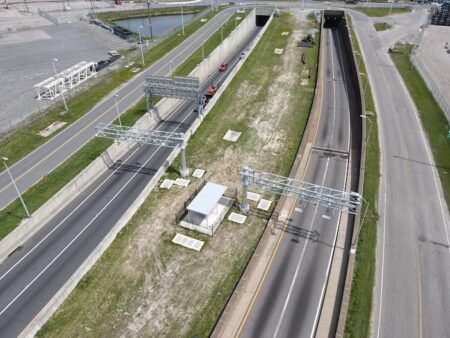The province of Ontario is launching Canada’s first High-Occupancy Toll (HOT) lanes as part of a pilot project on the QEW (Queen Elizabeth Way), which links Toronto with Buffalo in the USA, in order to help manage congestion and add another option for travelers.
The new pilot project will start on September 15, and existing high-occupancy vehicle (HOV) lanes on the QEW between Trafalgar Road in Oakville and Guelph Line in Burlington will be designated as HOT lanes. Carpools of two or more occupants will still be able to use the QEW HOT lanes for free, while single occupant drivers will now have the option to purchase a HOT permit to use them. HOT permit applications from members of the public will be accepted online from August 1-21, and a limited number of applicants will be selected to purchase permits through a draw. The permit will cost C$180 (US$139) for a three-month term.
As part of the pilot, Ontario is issuing a request for information (RFI) seeking innovative technologies that can be used to support tolling, compliance and performance monitoring of HOT lanes for the purposes of testing during the pilot. Possible technologies include telematics, radio frequency identification (RFID), video-analytics, GPS, and infrared cameras. The pilot will be used to inform long-term planning for future HOT lane implementation and will also support Ontario’s innovation sector by providing an opportunity to test emerging traffic management and tolling technologies.
The QEW was selected for the pilot because it has the greatest free capacity available during peak traffic hours of the three existing HOV lanes in the Greater Toronto Area, and would provide travel benefits in both directions throughout the day. No existing general purpose lanes on provincial highways will be removed for HOT lanes. The 10.2-mile (16.5km) section of the QEW will eventually connect with an additional 9.6-mile (15.5km) stretch of dedicated HOT lanes with electronic tolling in both directions on Highway 427, which will open in 2021, from south of Highway 409 to north of Rutherford Road.
Ontario is making the largest investment in public infrastructure in the province’s history, with about C$160bn (US$123bn) over 12 years, which is supporting projects such as roads, bridges, transit systems, schools and hospitals. In 2015, the province announced support for more than 325 projects that will keep people and goods moving, connect communities and improve quality of life. Creating new travel options and supporting innovation is part of the government’s economic plan to build Ontario up and deliver on its number-one priority to grow the economy and create jobs.
Steven Del Duca, Ontario’s Minister of Transportation, said, “This pilot project on the QEW is the first step of Ontario’s plan to implement HOT lanes throughout the region. The request for information will help us identify the latest technology to make HOT lanes efficient and well-managed. HOT lanes can benefit all drivers on a highway by improving travel times for everyone and keep the region moving.”




